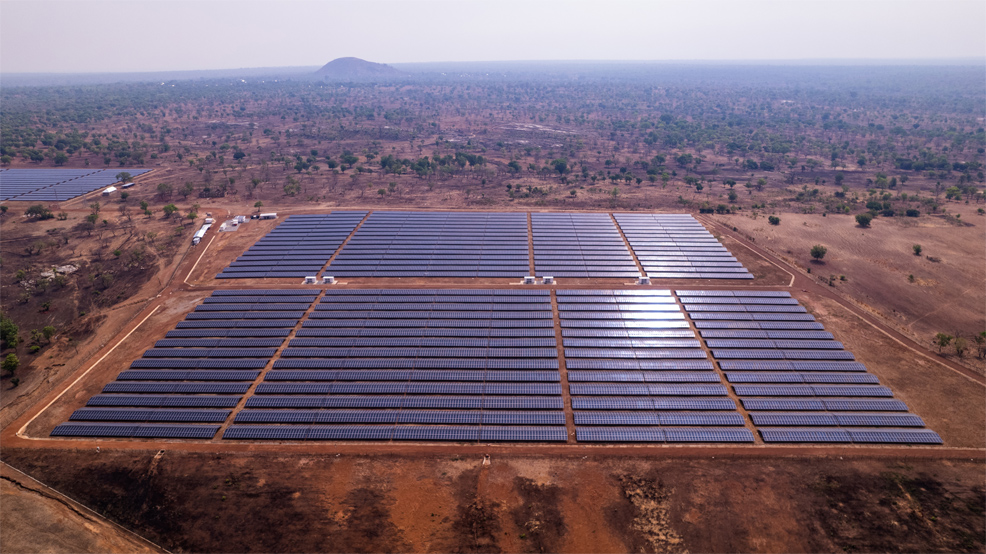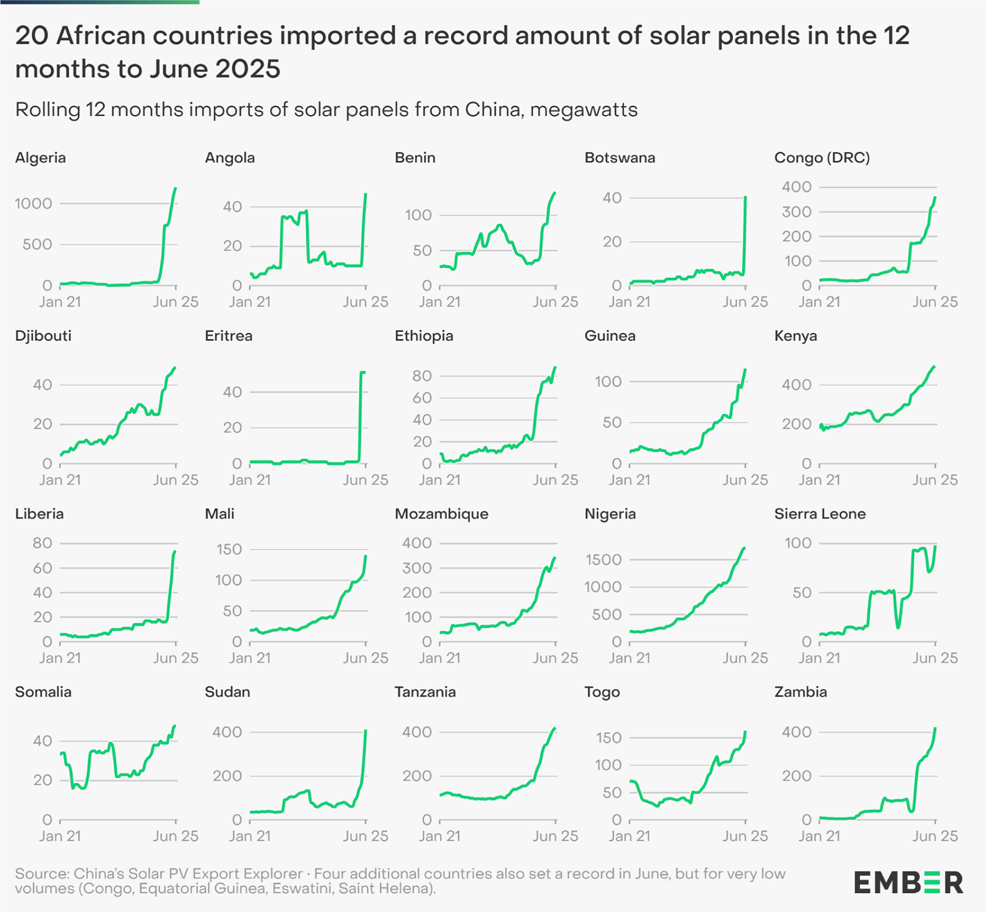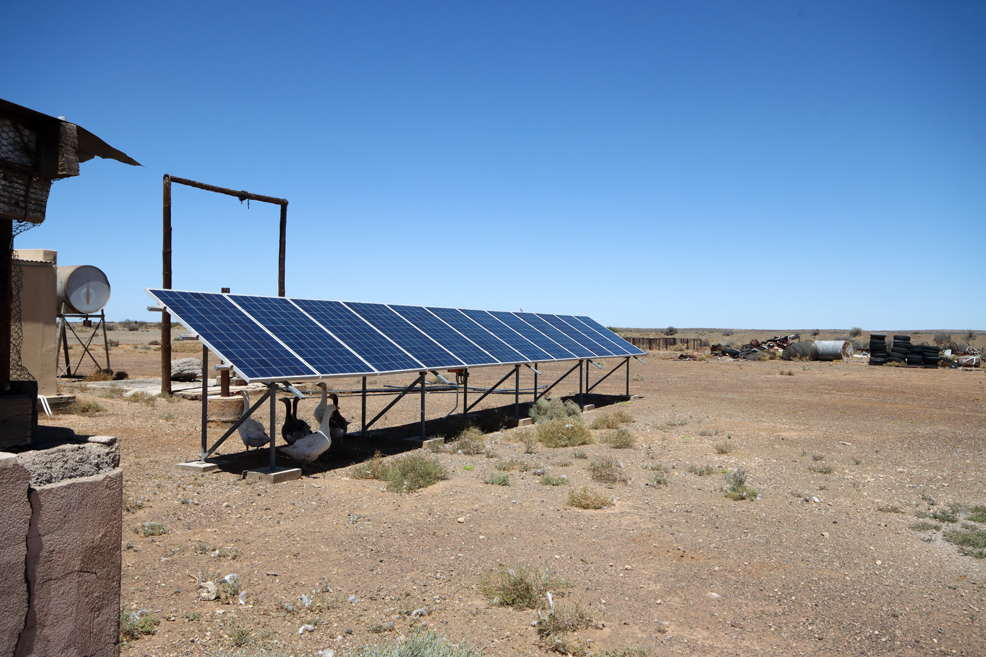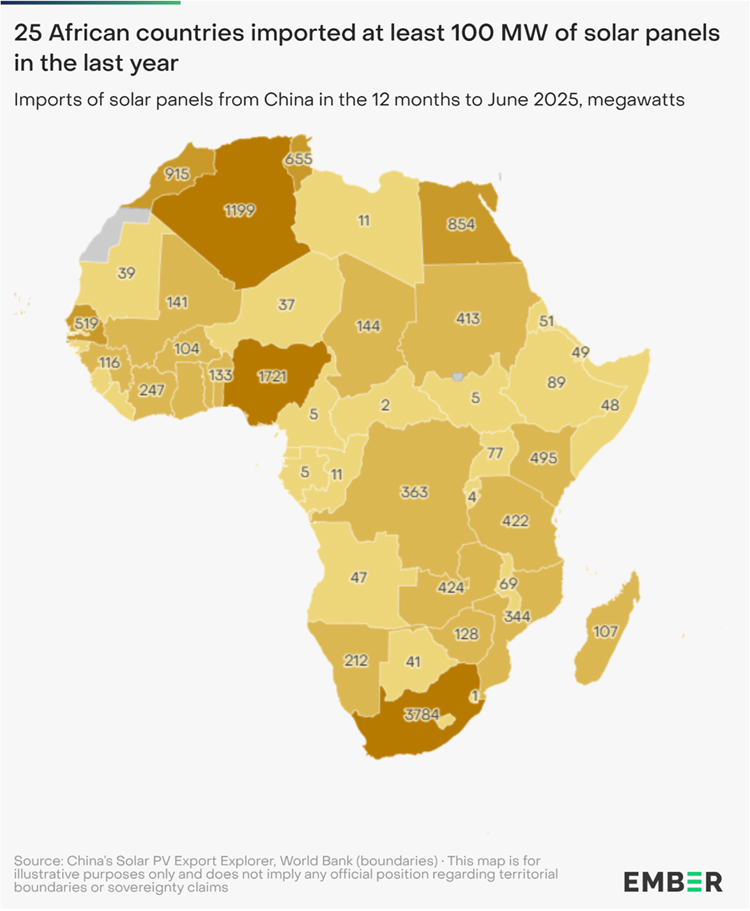
1st September 2025 Solar power is growing exponentially in Africa An inflection point in Africa's adoption of solar energy is now clearly visible, driven by record imports and rapid expansion across dozens of countries on the continent.
For years, critics of renewable energy have argued that Africa's economic future depends on extracting and burning more coal, oil, and gas, no matter the environmental cost. However, the reality on the ground is now telling a different story. The continent is beginning to harness one of its greatest natural assets – abundant sunshine – at a pace that suggests potential for massive scaling up. A new analysis confirms that solar power in Africa is now hitting the all-important knee of the exponential curve. The latest report from Ember, a London-based energy think tank, reveals that Chinese panel exports to Africa jumped by 60% over the past year, reaching 15,032 MW. This record high provides clear evidence of accelerating uptake and the first real signs of a solar take-off. Until now, solar power generation in Africa had been dominated by South Africa and Egypt, the only two countries on the continent with installed capacities measured in gigawatts, rather than megawatts. However, this may soon be changing. Over the last two years, imports outside South Africa almost tripled from 3,734 MW to 11,248 MW. The momentum is widespread. In the 12 months to June 2025, 20 countries set new records for solar imports. A year ago, only 15 countries managed more than 100 MW each. Now the number has risen to 25. The growth rates in some places are astonishing. Algeria's imports rose 33-fold compared with the year before. Zambia increased eightfold, Botswana sevenfold, and Sudan sixfold. Angola, Benin, the DRC, Ethiopia, and Liberia all more than tripled their imports.
Altogether, the imported panels would provide a combined average boost of at least 5% to electricity supply across 16 African countries. In several cases the increase looks transformative: Sierra Leone 61%, Chad 49%, Liberia 25%, Somalia 15%, Eritrea 15%, Togo 11%, Benin 10%. These high shares reflect modest starting points, so even relatively small additions move the dial. Urban and rural adoption are following different paths. In North Africa, governments invest in giant solar farms to feed national grids. In Sub-Saharan Africa, distributed solar is driving the change. Homes, shops, schools, and small factories increasingly turn to rooftop panels and community micro-grids. These systems can leapfrog unreliable grids and bring electricity to places that had none before. Today, 82% of the urban population in Sub-Saharan Africa has access to power, compared with only 33% in rural areas. Distributed solar offers the fastest way to close that gap.
The economics are compelling. Many African countries rely heavily on diesel generators, often at eye-watering costs. In Nigeria, a single 420-watt solar panel costing $60 produces around 550 kWh a year. The same $60 spent on diesel yields just half that energy. As a result, the panel pays for itself within six months. Diesel is even more expensive in neighbouring countries, so the payback is faster still. The implications are big. Almost one-third of countries in Africa have more diesel generator capacity than on-grid power plant capacity – with 28 GW in Nigeria, 10 GW in Ghana and 8 GW in Kenya. Solar panels can directly replace diesel generation and therefore replace oil imports. Yet even with such clear advantages, a number of barriers remain. Although $60 may sound cheap, for a typical African household it represents a sizeable share of monthly income. Unlike diesel, which can be purchased in small daily amounts, solar energy requires upfront investment along with inverters, batteries, and proper installation. High interest rates make credit scarce, fossil fuel subsidies tilt the market, and supply chains for panels and equipment remain thin outside a few countries. These hurdles slow adoption, even as the long-term economics strongly favour solar. Most panels still arrive from China, which supplies more than 80% of the world's solar manufacturing. Yet Africa's own industry is stirring. Morocco recently doubled its capacity to 1 GW per year, and South Africa produces similar volumes. Egypt is preparing to bring three gigawatt-scale factories online between 2025 and 2026, led by EliTe Solar, Sunrev Solar, and Masdar. If these projects succeed, Africa could begin to localise part of its supply chain, adding jobs and resilience.
The experience of Pakistan offers a glimpse of what might come next. In just 12 months, Pakistan's solar imports tripled. By mid-2025, it imported more panels than the whole of Africa, despite having one-sixth of the population. Ember stresses that Africa is not yet the "next Pakistan" – but the same conditions exist: unreliable grids, high energy prices, abundant sunshine, and access to cheap Chinese panels. Change can happen fast once the curve steepens. Beyond growth figures and economics, the benefits of solar reach into everyday life. It reduces the need for kerosene lamps, charcoal fires, and smoky diesel. Families breathe cleaner air, fire hazards decline, and deforestation slows as communities cut fewer trees for fuel. A study in 2021 found that indoor air pollution causes 697,000 deaths each year in Africa, while ambient air pollution causes a further 394,000. Scaling up solar directly addresses these health and environmental risks. Africa now stands at a tipping point for solar. Imports of panels are soaring, utility-scale projects are growing ever larger, and distributed systems are spreading. With the right policies, financing, and planning, the continent could soon follow the same exponential path as other parts of the world. If captured and harnessed at scale, its abundant sunlight promises not just electricity, but cleaner air, healthier societies, more resilient economies, and a more sustainable future for all. "The take-off of solar in Africa is a pivotal moment," said Dave Jones, Chief Analyst at Ember. "This report is a call to action, urging stronger research, analysis, and reporting on solar's rise – to ensure the world's cheapest electricity source fulfils its vast potential to transform the African continent."
Comments »
If you enjoyed this article, please consider sharing it:
|
||||||










